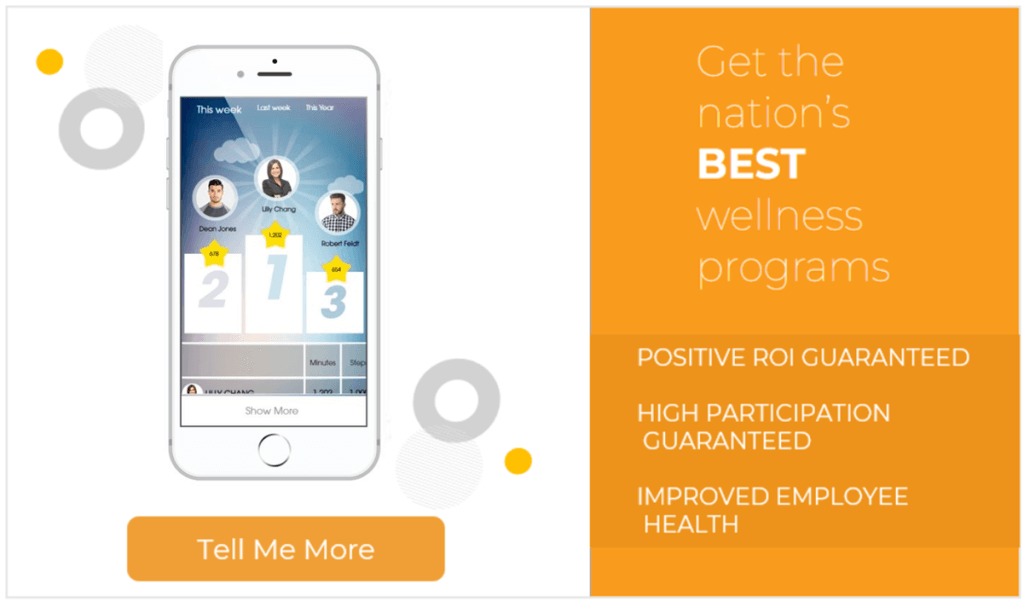How Do You Increase Engagement for Wellness Programs?
A wellness coordinator from a large bicycle manufacturing company was struggling to increase true wellness program engagement and get their wellness program to produce the kind of outcomes that the CEO wanted to see. They had excellent program participation and yet they were not seeing improvements in health or reductions in healthcare costs.
Upon further questioning, part of the problem was that if their employees completed a health and wellness risk appraisal and biometric screening, they could earn a discount on the cost of their insurance premium. But if not, they were required to pay the full cost of their insurance.
By not participating, they would have to pay the employee AND the employer portion of their healthcare costs–about $1500 every single month. Naturally, everybody was participating because they did not want to pay $1500 every month.
The program had great participation but it had terrible engagement.
This type of wellness program engagement is what is known as “hollow” engagement. Employees are going through the motions of participating in the wellness programming, but their hearts were just not in it. They were essentially being forced to participate. No one likes to be forced to do anything and forcing people to be healthy is never going to work.
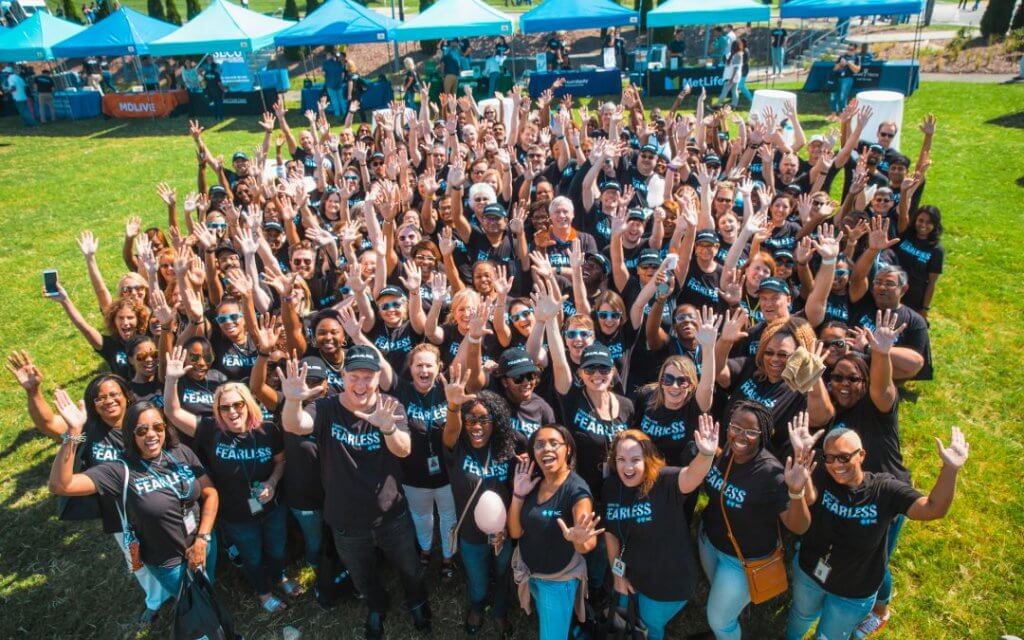
Without sincere, honest wellness program engagement from employees, it’s impossible to have successful wellness outcomes. An indicator of a successful program is really good wellness engagement. This success can help justify the cost and work involved in having a wellness program available to your employees.
Wellness engagement is the first step employees must take before they will be able to adopt and maintain healthy behaviors and enjoy all the benefits that come from having a healthy lifestyle.
Just about everybody in the wellness industry can remember the stages of change model.
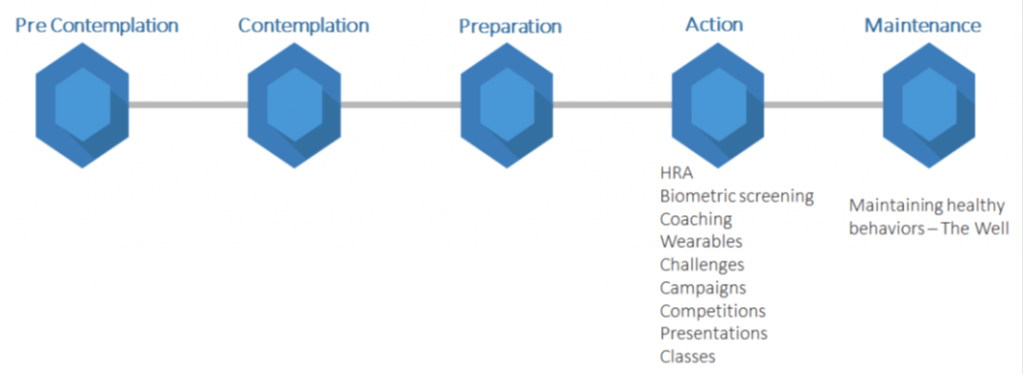
This behavior change model has been around for several decades and it does a great job of explaining the process we all take when we change behaviors. It’s really pretty easy to understand: it starts with individuals going through the precontemplation stage, followed by contemplation, preparation, action, and finally maintenance.
It’s a very accurate description of how people adopt and maintain healthy behaviors and it also provides a really good way for us to understand what it means to have wellness and employee engagement.
People who are in the action stage of change are actively doing something to improve their health. That could be completing a health risk appraisal, biometric screening, health coaching, using a wearable device, participating in behavior change challenges, team competitions, listening to presentations, etc. You get the idea.
People in the action phase of behavior change are taking action to improve their lives and this is exactly where wellness engagement happens.
As we describe wellness program engagement, we are usually talking about people doing something in the action of behavior change. This is good, but it is not the ultimate goal of having a wellness program. Remember, the stages of change model ends when someone maintains a healthy behavior for a long time. The maintenance stage is where we really want every one of our employees to arrive.
The big, audacious goal of every wellness program should be to have every single employee be actively engaged in healthy behaviors for the rest of their lives. However, very few people are able to do this.
Very few people have healthy diets, exercise regularly, avoid tobacco products, or don’t drink in excess. Yet, this is exactly where we would like most people to end up.
How we define wellness program engagement is really up to the individual worksites. It should be based on what their goals and objectives really are. If a program is just starting, your program goal may be to get people to complete a health risk appraisal. In that first year, completion of your health risk appraisal may be your measure of employee engagement.

However, as a program matures, getting people to actively participate in behavior change strategies and helping them create and sustain healthy cultures at work may be a more accurate and effective definition of wellness program engagement.
There is another way to look at wellness engagement. Think about weight loss programs: a lot of studies have been performed on the effects of weight loss programs. Almost all of them have short-term success.
Within the first three, six, or nine months just about everybody’s going to lose weight in some form. During this initial weight loss period, people are actively engaged in eating differently, controlling caloric intake, and being active.
This could be considered the action or engagement phase. Most people are pretty successful in the engagement phase. However, after the initial efforts have taken place, real success in a weight loss program will be determined by whether or not they keep the weight off.
Reaching an ideal body weight and maintaining it for years to come is maintenance. Most weight loss success occurs in the engagement phase. Maintenance is much harder. The same thing often happens with nutrition interventions. In the beginning of a healthy eating wellness program, many employees will increase the number of fruit and vegetable servings they are consuming.
But with time, the majority may not maintain that healthy level of consumption. To help us understand the difference between engagement and maintenance, think of wellness engagement as taking the initial steps to begin a lifelong pattern of healthy behaviors. Without the initial steps, long-term behavior change is not likely to happen
To Whom Does Wellness Engagement Apply?
Think about your entire workforce as being represented in the graph below. It shows 100 employees of just about any typical workforce.
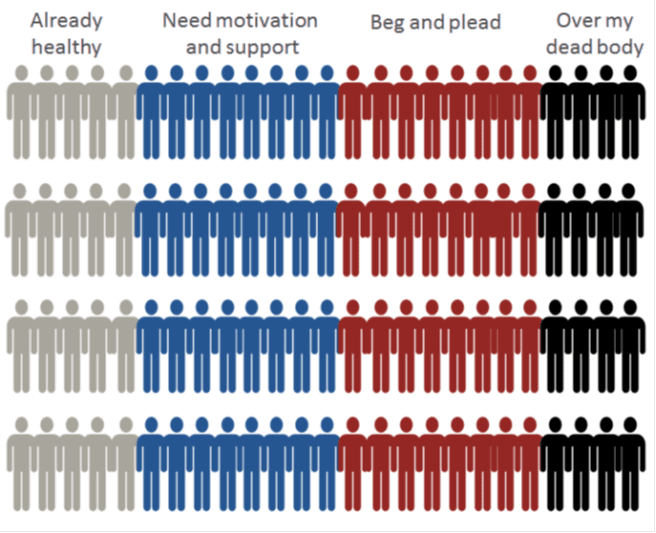
About 20% of all employees (in grey) are already eating healthy, exercising and avoiding tobacco. Quite frankly, they don’t need your wellness program because they’re already maintaining a healthy lifestyle.
Yes, we want them to continue, but even without your wellness program they’re probably going to enjoy all the benefits of healthy living.
Then there’s the next group in blue, which will participate and engage in your wellness activities. But they’re going to need some motivation and some support. Incentives are pretty effective at getting these people to start the wellness engagement process.
Then there’s another 30% of the workforce (in red) that is going require a lot of effort on your part to get them to engage. You are going to have to beg and plead to get these people to begin to engage in wellness activities.
Your effective marketing efforts, posters, communications, and leadership support will go a long way to getting this group to more fully engage in wellness activities.
And then there’s the last group in this chart, the group in black. They represent about 5 to 12% of every population of workers. We call this the “over my dead body” group. They may never engage in wellness activities, they think their health and wellness is none of your business, and they think they should be free to do whatever they want to their own bodies regardless of who is paying for their cost of medical care.
This group will, perhaps, engage in wellness activities, but they will require constant encouragement, incentives, and peer support before they are really going to begin to taste the benefits of healthy living.
When we take a look at wellness engagement from this perspective, we can see that wellness and employee engagement really involves about 75% of your employees who are not already maintaining healthy behaviors. This is the target of all of our wellness program engagement efforts.
Our role as wellness professionals is to try to get people to do something they do not want to do. Not everyone likes the taste of fresh fruits and vegetables, they would prefer chocolate, soda, and Cheetos. Successful wellness program engagement requires us to get people to do something they do not want to do–start living healthy lifestyles.
There is some great published scientific literature on the different factors and processes that are required to get people to engage in wellness. WellSteps has been offering employee engagement wellness programs for over a decade. Our programs have seen great success and some unfortunate failures.
If a worksite is not willing to take the right steps, WellSteps can only do so much to help companies have successful wellness program engagement. We’ve been able to identify the most important factors companies need if they are to have positive wellness outcomes.
What should a wellness program include? When we combine the evidence from the different research studies with our real-world experience on what makes a successful program, we come up with the WellSteps Engagement Model.
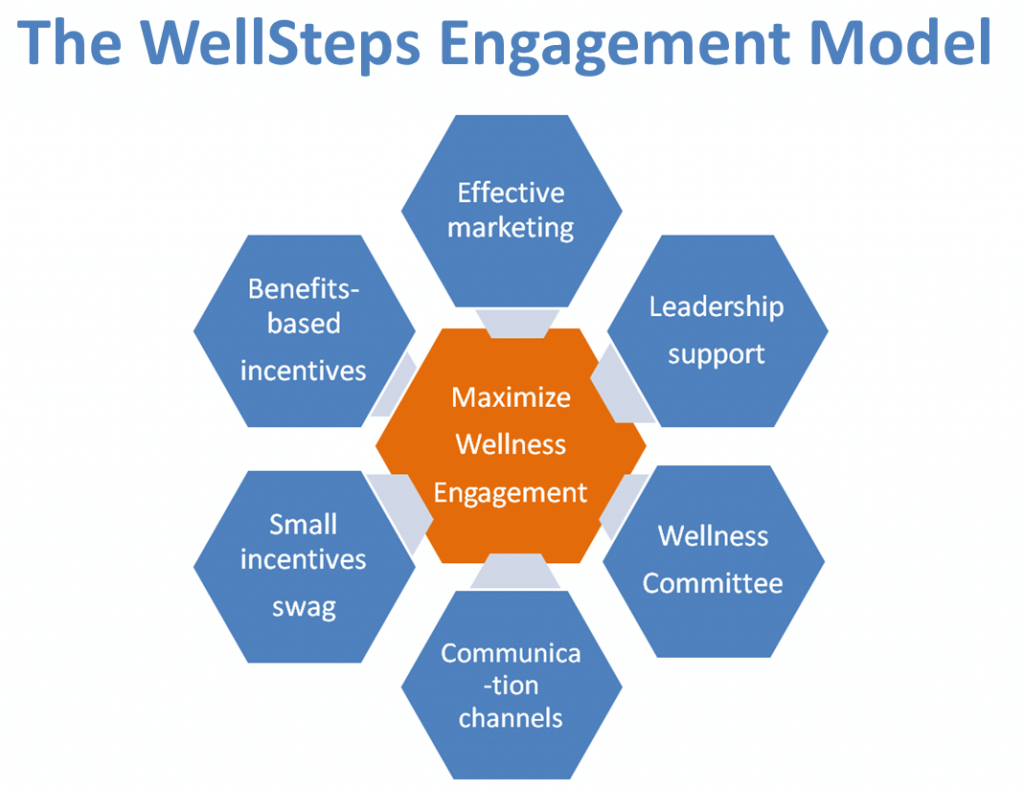
This model has five important parts. Find an effective worksite wellness program that is successful at improving employee health behaviors and health risks and you’ll quickly see that it contains each of these five elements.
- Effective use of incentives
- Effective marketing strategies
- Multiple communication channels
- Strong leadership support
- A functioning wellness committee
Here is an in-depth look at each element.
1. Wellness Engagement Incentives
The best wellness programs use two types of incentives. We call one small incentives or wellness swag, and the other is a larger, more potent benefits-based incentive. Before we talk about the difference between the two and how they should be set up to have the most effect on wellness engagement, you should ask yourself this question: Among people who exercise regularly, why do they do it?
Many of you reading this blog right now have healthy lifestyles that include regular, consistent physical activity on most of the days of your life. Why do you do this?
For those that have made exercise a lifetime habit, the reasons for continuing to be active are almost exclusively focused on the intrinsic rewards they get from the behavior. People who exercise regularly do so because they like the way it makes them feel. They like:
- the way exercise can reduce their stress
- the way exercise makes their body look and feel
- the weight control benefits of being active
- and, typically they like to compete.
Each of these reasons is intrinsic: they come from inside the individual. They provide personal satisfaction.
Intrinsic rewards such as these take a while to be experienced and appreciated. You can exercise for the first time ever and you’ll get little, if any, intrinsic value out of it. These intrinsic motivators take time to develop and they are found in all long-term habits that we possess. Sometimes they can change over time.
For example, competitive sports provide an intrinsic reward of competition with others, but as we get older, the need to compete might be replaced by the benefits of good health and healthy body. Contrast intrinsic motivators to extrinsic motivators.
Extrinsic motivators come from outside of us. These are the typical incentives we hear about in wellness programs. Sometimes we can refer to these as carrots and sticks–some form of external reward that we use to facilitate wellness program engagement.

When we give extrinsic rewards like cash, gift cards, water bottles, or a T-shirt, we can induce some employee engagement in wellness just by the desire that comes from wanting the reward. These rewards are great for giving immediate, short-term feedback.
But they may not lead to intrinsic motivation and they don’t always lead to long-term habits. Remember the group of employees that are already physically active and healthy?
Well, whether or not you have a wellness program, they’re going to continue to be healthy, and whether or not you offer them and extrinsic reward for their wellness engagement is irrelevant to them. They maintain healthy behaviors because they like the intrinsic benefits they get from those behaviors.
They don’t need any extrinsic motivation because they have a whole bunch of intrinsic motivation and it is this type of motivation that we want everyone to enjoy. The challenge is getting people to start to engage in wellness activities and gradually lead them away from external reward toward more powerful internal (intrinsic) rewards.
The best way to do this is to start with extrinsic motivators for wellness engagement–short-term, small incentives like gift cards or T-shirts combined with larger, more meaningful, more valuable, benefits-based incentives.
The small, short-term incentives provide immediate rewards for employee engagement in healthy behaviors such as completing a personal health assessment, biometric screening, or a behavior change campaign.
As they progress and have more and more success they build points and earn a larger benefits-based incentive, such as a discount on their insurance premium, or lower co-pay or deductible.
The key is to help every single employee transition from external incentives to intrinsic rewards. WellSteps does this with every single component of every wellness program. When you participate in the Move It Coast to Coast campaign you will learn how to be active and be part of a team to compete with other teams.
You’ll also learn about the various internal benefits that come from having a healthy lifestyle. You learn about all of the life-altering benefits that come from being physically active. Oh, and by the way, you might qualify for a small incentive or benefits-based incentive.
We don’t make a big deal of the extrinsic rewards, we make a big deal of the intrinsic motivators so that by the end of the campaign people have discovered that something in their life has changed: they may sleep better or feel better or have lost weight and they like the way they feel.
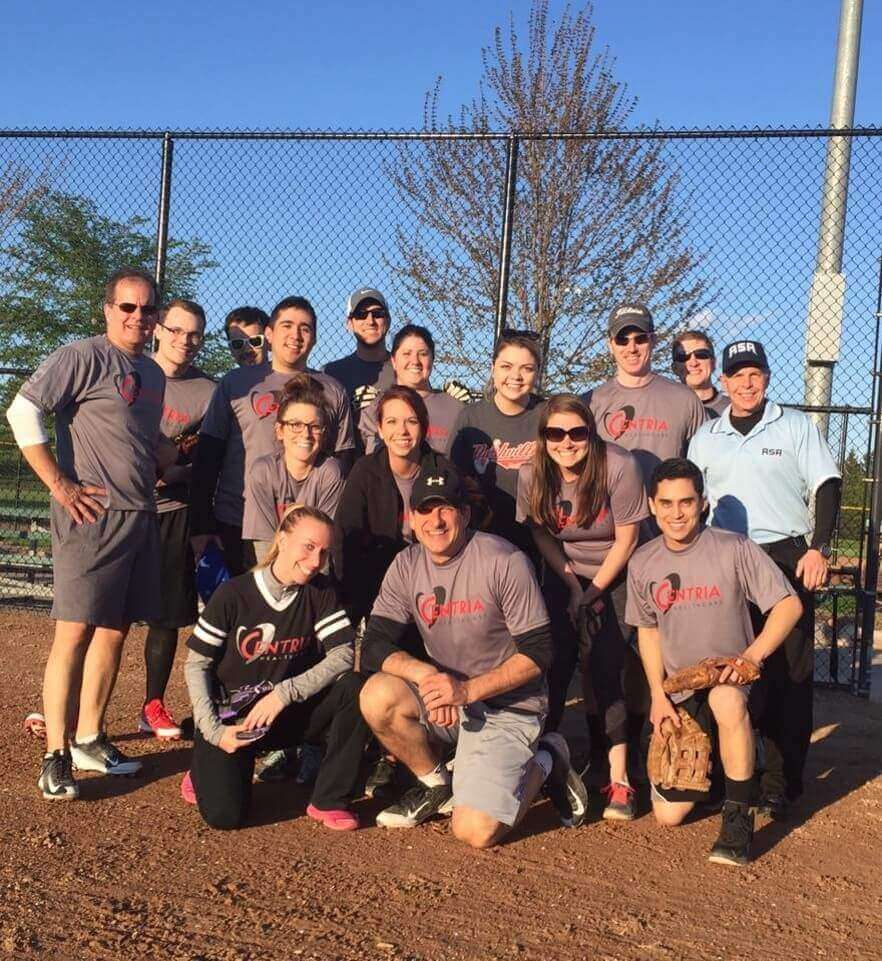
When this happens, the person is well on his/her way to creating a long-term sustainable habit. Successful wellness program engagement is more than just participation: it is the first few steps toward the beginning of a new life.
Think back to our example with the stages of change model. Those in the action stage require extrinsic rewards to support their initial activity. Those in the maintenance stage of the model maintain their activity or their new behaviors because of the intrinsic rewards that they get.
If we fail to help employees transition from motivation from extrinsic rewards to motivation from intrinsic rewards, it’s highly unlikely that the behaviors will persist much further than the end of your wellness activity.
To help you make the most out of incentives here are a few rules (commandments) that we use in every program to help companies maximize their wellness program engagement:
- Use incentives, but don’t make a big deal of them. Make a big deal out of the benefits.
- Make sure your employees know what all the benefits of wellness engagement are. Give them a “What’s in it for me?” list.
- Never use sticks; never punish people for lack of wellness program engagement.
- Delayed or negative consequences have little impact on behavior.
- Use both intermediate and benefits-based rewards.
- Start with external reward but help employees transition towards intrinsic ones.
To learn even more about incentives, especially benefits-based incentives, check out this article.
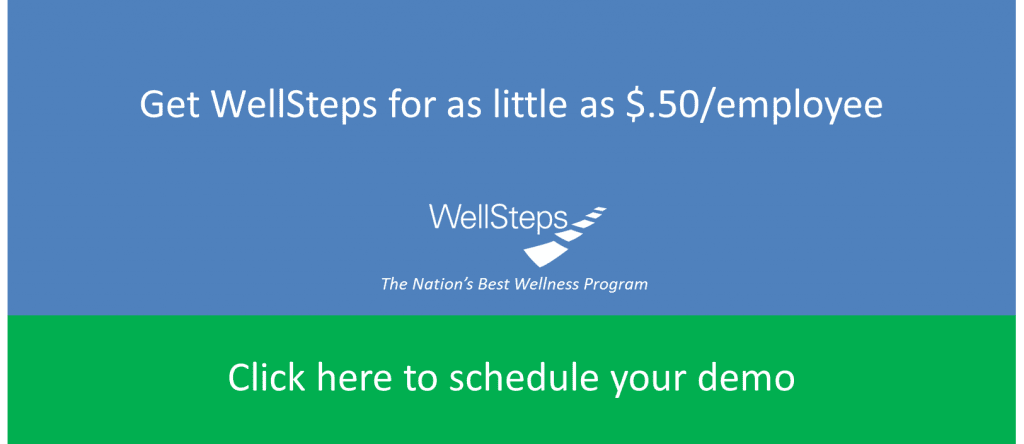
2. Effective Marketing
If you are a wellness professional or former professor, you spent many years studying or teaching behavior change models, processes, and strategies. But outside of the ivory tower, the truth is you see that human behavior is greatly influenced by marketing.
That’s right, good old fashioned marketing has a big impact on the way people live their lives. And well-designed marketing has an even bigger impact.
To get your employees to engage in wellness activities, you need to have effective marketing. This consists of three steps:
- Use written words (compelling copy) that compel people to act.
- Offer something of value for wellness program engagement.
- Include a call to action–the thing you want the person to do.
Compelling Copy
The messaging and information we communicate with our employees will make a big difference as to whether or not they participate. People will participate in your program if you help them solve a problem.
These are not your problems, your worksites problems, or your CEOs problems. These are personal health and well-being problems that most people struggle with.
Here are a few examples of problems that your employees want help solving:
- I want to lose weight.
- I want to be more fit.
- I want to improve my sleep.
- I want to look good for my 30th year high school reunion.
- I want to avoid chronic diseases; I don’t want to develop diabetes.
- I want to be able to be active and spend time with my grandkids.
- I want to be able to travel and be involved in my community when I get older.
- I want to feel good.
These are the problems your wellness program should be solving. These are the real, personal, challenges that most of us face. When you offer to help me resolve my challenges or make my life better, I’m listening, and I’m interested in what your wellness program can do for me.
Offer Something of Value
If I participate in your wellness program, what am I going to get out of it? Obviously, this could include the small and benefits-based incentives you are planning. But this also includes the benefits that they will get when they adopt and maintain a new healthy behavior.
When your employees participate in your programs, they need to know exactly what’s in it for them. Better health, lower weight, better tasting food, the need for fewer medications, less stress–you get the idea. Maybe they’re looking for hope, friendship, or just plain happiness.
Whatever you are doing in your wellness program, you need to communicate what the benefits will be. This is how we offer them something of value.
As your employees give you their time, effort, and undivided attention, you need to carefully explain to them what they will get in return. If what you are offering is of sufficient value, they will engage in your wellness program.
Think of it as a contract between your wellness program and your employee. The wellness program will offer certain benefits if the employee will engage.
Include a Call to Action
This is the easiest part of effective marketing but it’s the one we most often forget. Tell your individual employees exactly what you want them to do: register today, sign up now, join us, get screened, take the HRA, or walk at lunch.
Tell them what you want them to do and then tell them again. You’ve written compelling copy and you have their attention, you’ve clearly stated your value proposition, and they know what they can get out of this program if they engage.
Now tell them exactly what you want them to do. These three steps seem pretty simplistic and it is sometimes easy to dismiss them as too elementary. But after 10 years of experimenting with hundreds of thousands of employees, WellSteps considers these three steps to be our marketing commandments.
Every communication made with employees is driven by this process. To help you with more examples and more ideas, we made an infographic that you can use and share with others the provide even more detail about how to implement effective marketing steps in your wellness activities. You can get it here.
Put It All Together
Below is one of the posters that we use for our Stress Free campaign. It shows these three steps as they actually appear in our marketing materials. The compelling copy includes the question, “Stress free?” Followed by “Feel less stressed now”. That’s the compelling copy.
The value proposition is, “Learn simple steps to reduce the stress in your life”, and “When you finish, you could win a $50 gift card!” The last step, the call to action, includes the words, “Join us for the Stress Free campaign” and “Register at wellsteps.com/welcome”.
Every WellSteps behavior change campaign uses the same formula to engage employees in wellness programs. Every webinar that we share with the public has an announcement that uses this same formula, every email and every text message that we push uses this same formula. It is a key reason why our program engagement across hundreds of companies is greater than 77%.

3. Communication Channels
Today, more than ever, there are a lot of things competing for our attention. Your wellness program needs to be communicated in multiple ways and at multiple times if it is to be effective.
Once you have your effective marketing materials in place, you need to get it in front of your employees. You are going to need to use email, printed materials, newsletters, your website, posters, tabletop tents, meeting announcements, staff meetings, text messaging, Facebook, new employee orientation, calendars, streaming video, and my favorite–spouses and significant others.
You may not have success getting the employee to come to your wellness program, but your chances go way up when you target your employees’ spouses and significant others. Peer pressure from spouses and significant others can be a significant driver to engagement. Without it your programs engagement will suffer.
Wellness program engagement is really nothing more than selling. We’re selling the benefits of a healthy lifestyle.

4. Wellness Committees
Every successful wellness program has a wellness committee composed of a representative sample of employees. Having a committee will improve your programs engagement because it gives your employees a sense of program ownership.
When they feel like they have control and say in what happens and how it’s done, all of a sudden the program becomes their program, and they are inherently obligated to participate.
You will need to keep some control over the direction and administration of your wellness program but try to incorporate some of the ideas and suggestions that your employees may have. Some of the ideas may not be very good.
Others can easily be implemented into your yearly wellness calendar and your program will get a lot of mileage out of these employee-driven program ideas. Your wellness committee can also help to promote the intrinsic rewards and motivation that come with participating in the program.
An effective wellness committee helps drive the wellness program from the bottom up, not from the top down. That sense of ownership does a lot to impact morale and enjoyment.
Your wellness committee can also help communicate the program. Don’t forget to acknowledge them when the program is successful because without the wellness committee, you may not be successful.
To learn more about having outstanding wellness committees read here.
5. Leadership Support
The last critical element to maximizing program engagement is to have strong leadership support. Getting strong leadership support requires both art and science. You should read this blog that is the complete guide to getting strong leadership support.
If you want to have a successful wellness program with maximum employee engagement, please follow the steps and guidelines in this blog to help you acquire and strengthen your leadership support for your wellness efforts.
Many wellness professionals have suggested that senior leadership support is one of the most important aspects of getting good program engagement. Every successful wellness program has strong leadership support.
This Is What Wellness Engagement Is Supposed to Look Like
WellSteps has been using this process for many years. It’s not enough to get your employees to participate in a health risk appraisal or to do a biometric screening. While these are good efforts, they are not sufficient to help your employees adopt and maintain healthy lifestyle behaviors.
It takes much more than that. When each of these engagement steps are followed, you have the best chance possible of getting positive outcomes out of your wellness program and you will transform the lives of your employees.
Many of your employees will be able to transition from just program engagement to actual maintenance of healthy behaviors. Isn’t this the long-term goal of all of our wellness efforts? Employees who are able to maintain healthy behaviors have lower health risks and lower employee related expenses, such as healthcare cost, absenteeism, and presentism.
If the goal of your wellness program is to improve employee health and reduce employee related expenses, then you will need to follow these steps to maximize your wellness program engagement.
WellSteps wellness solutions have the industry’s best performance guarantee because we are fanatical about maximizing employee engagement. If you’d like to see the complete WellSteps engagement model in action, give us a call and let one of our WellSteps sales experts show you what your worksite wellness program could look like.
